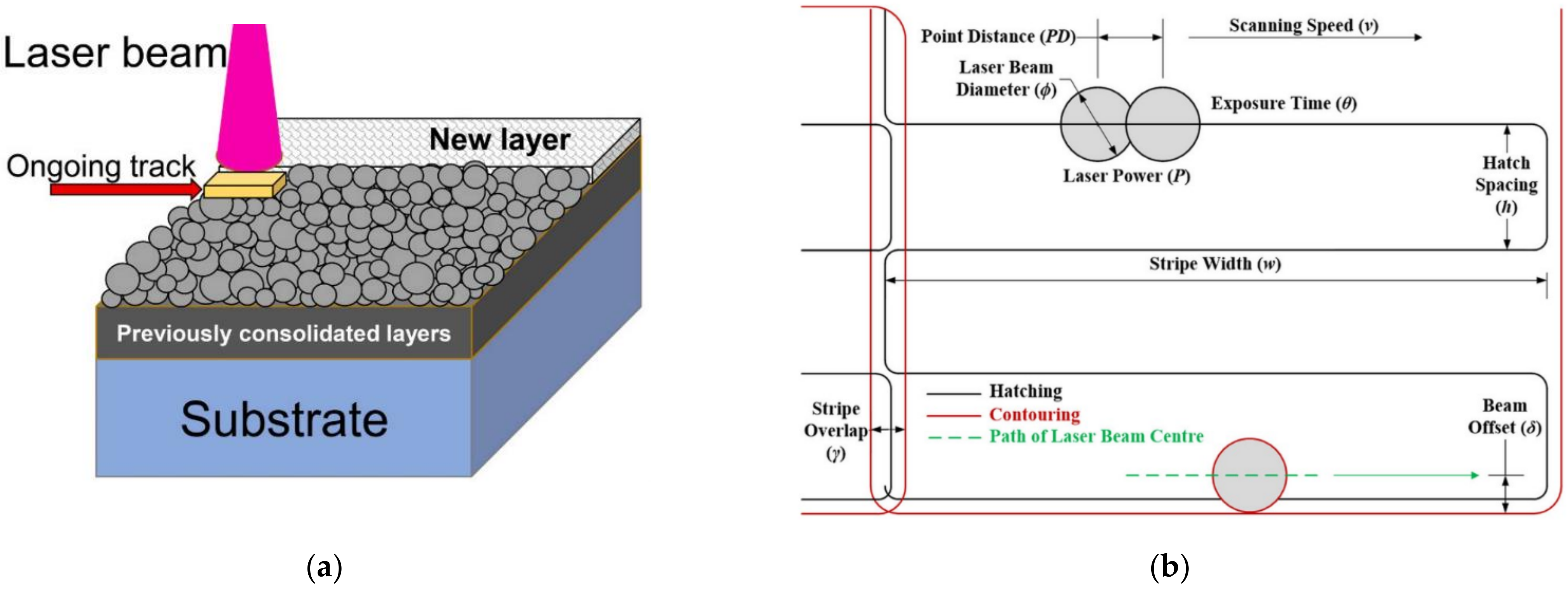Laser Powder Bed Fusion of Unalloyed Tungsten: A Review of Process, Structure, and Properties Relationships
Abstract
:1. Introduction
2. Process
2.1. Selection of Feedstock and Substrate
2.1.1. Feedstock


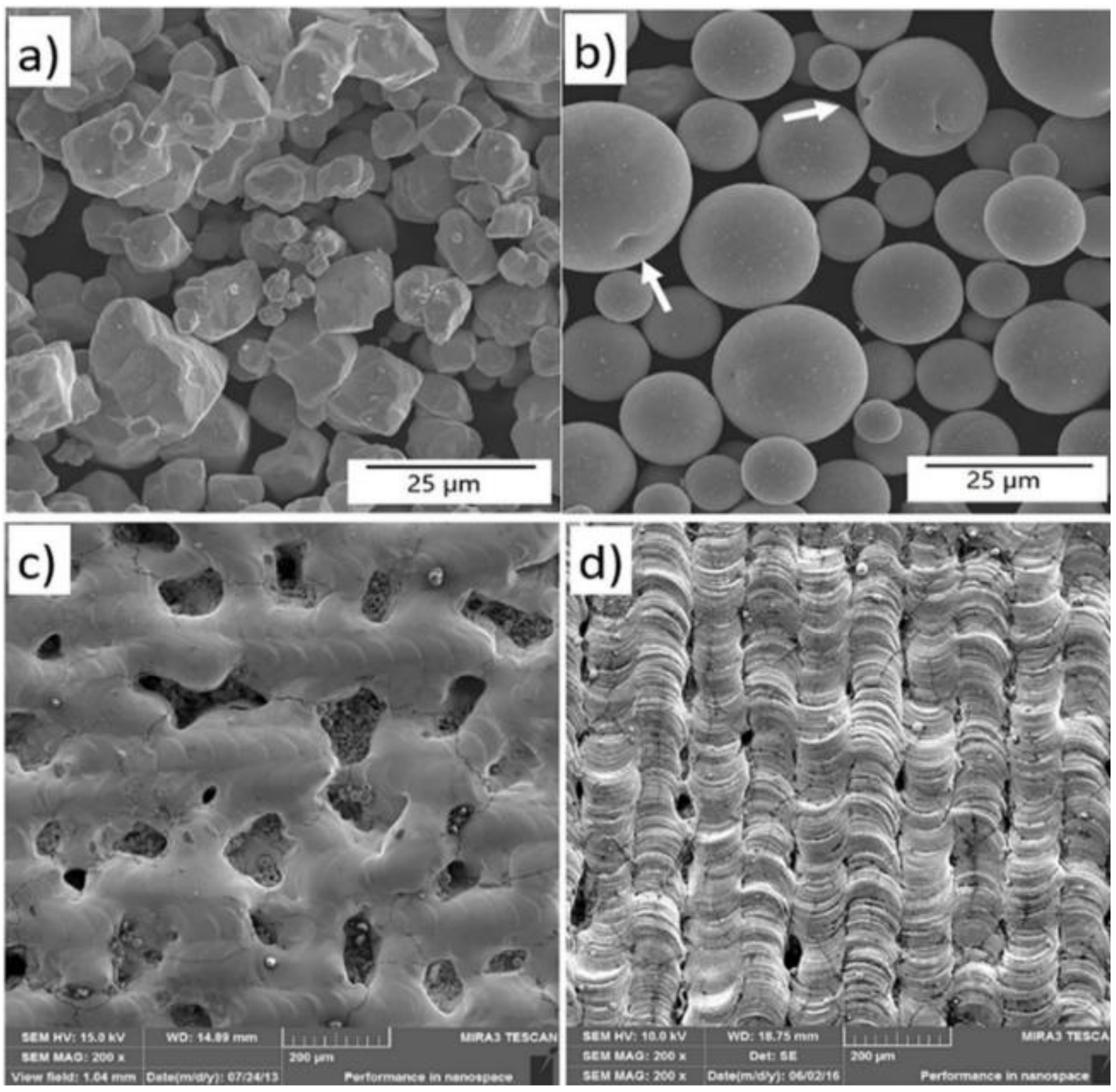
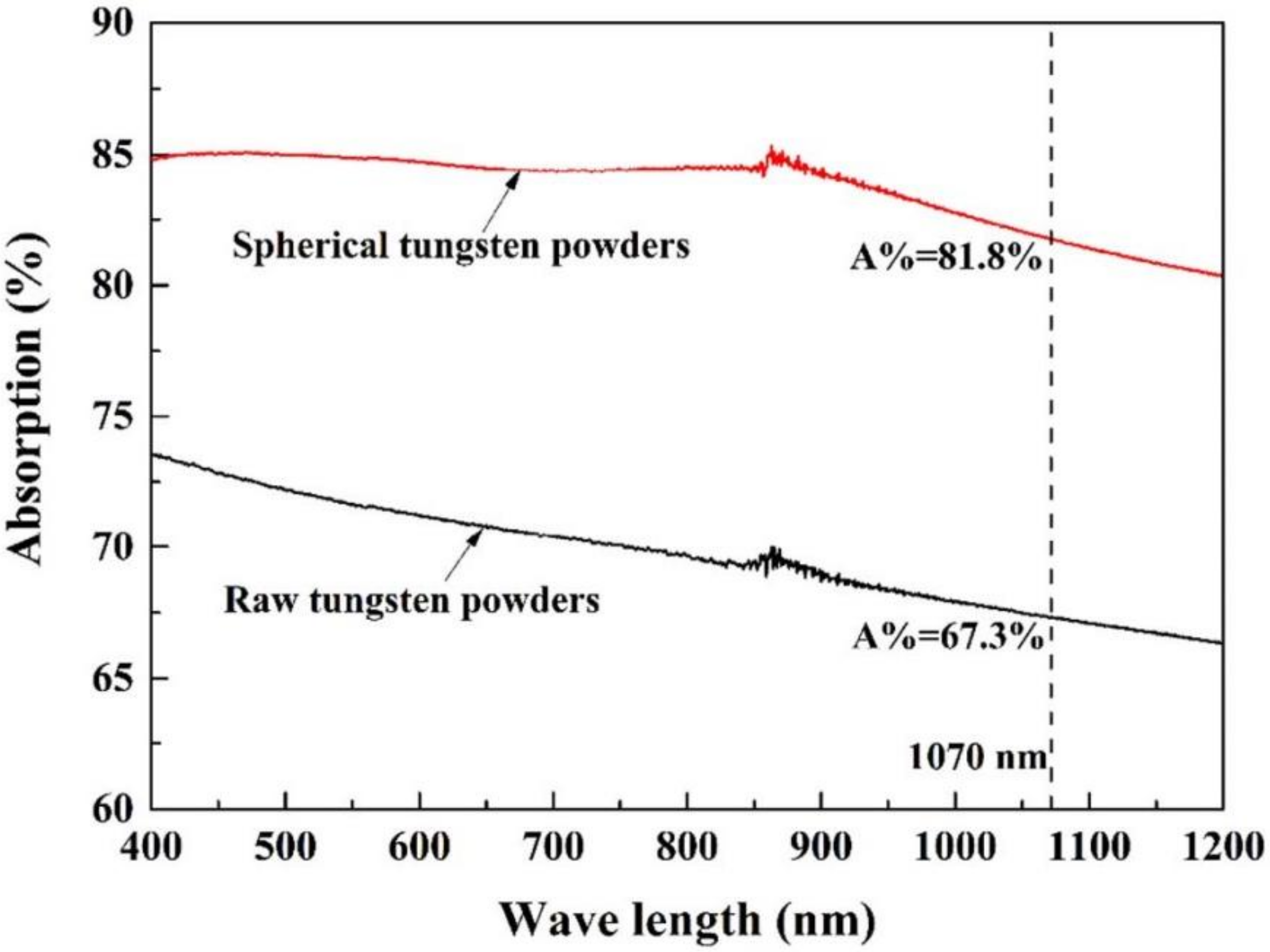


| Relative Density | Powder Size Distribution (μm) | Substrate Material | Ref. |
|---|---|---|---|
| 98.71% | D10 = 9.04 | - | [37] |
| D50 = 14.8 | |||
| D90 = 23.7 | |||
| 98.7% | D10 = 17.7 | - | [36] |
| D50 = 27.4 | |||
| D90 = 41.8 | |||
| 98.7% | 15–53 | Tungsten | [44] |
| 98.51% | 5–25 | 316L stainless steel | [38] |
| 98.50% | D10 = 10.47 | - | [39] |
| D50 = 16.24 | |||
| D90 = 23.67 | |||
| 98.5% | 15–45 | Tungsten | [40] |
| 98.4% | D10 = 10.4 | - | [41] |
| D50 = 15.8 | |||
| D90 = 23.8 | |||
| 98.4% | D10 = 8.25 | Stainless steel | [43] |
| D50 = 14.41 | |||
| D90 = 24.25 | |||
| 98.31% | D10 = 10 | 316L stainless steel | [42] |
| D50 = 15.87 | |||
| D90 = 24.86 | |||
| 97.3% | D10 = 8.5 | Tungsten | [35] |
| D50 = 31.1 | |||
| D90 = 41.31 | |||
| 97.5% | D10 = 10.3 | - | [47] |
| D50 = 16.6 | |||
| D90 = 28.2 | |||
| 97% | 42–52 | Titanium | [48] |
| 97% | D10 = 9.04 | Tungsten | [49] |
| D50 = 14.8 | |||
| D90 = 23.7 |
2.1.2. Substrate
2.2. Process Maps
2.2.1. Single Track
2.2.2. Process Maps for Bulk Objects

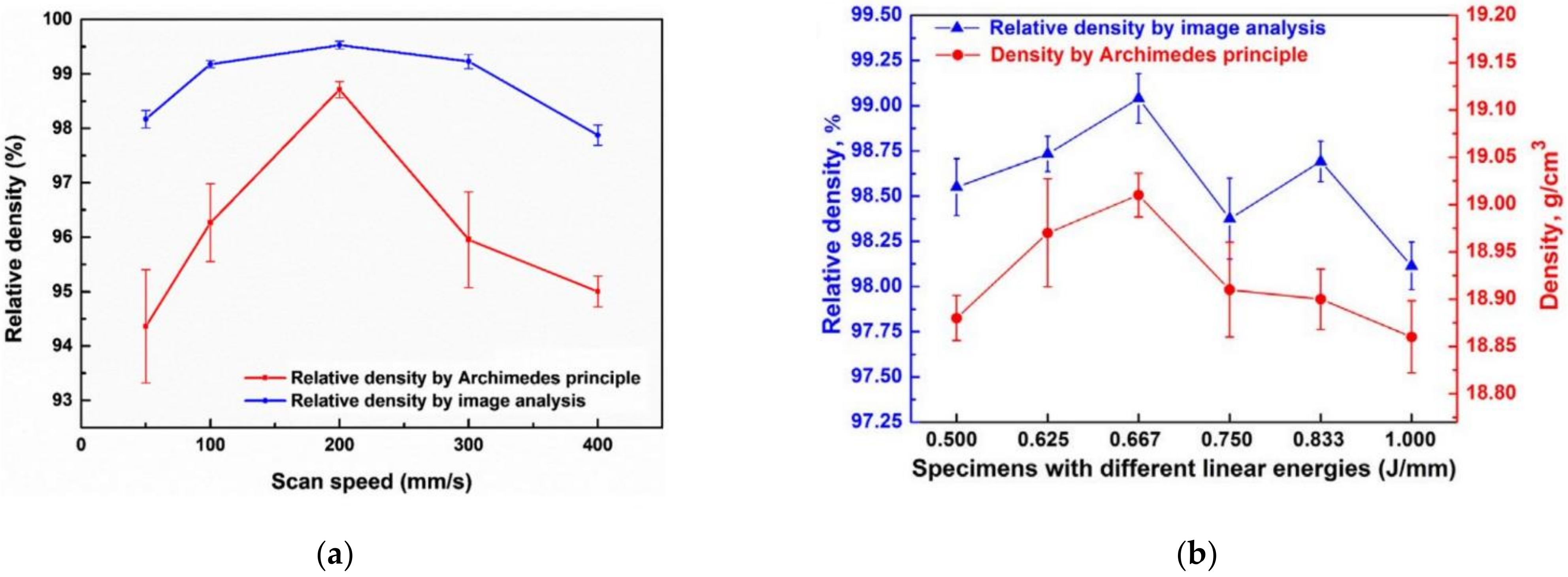
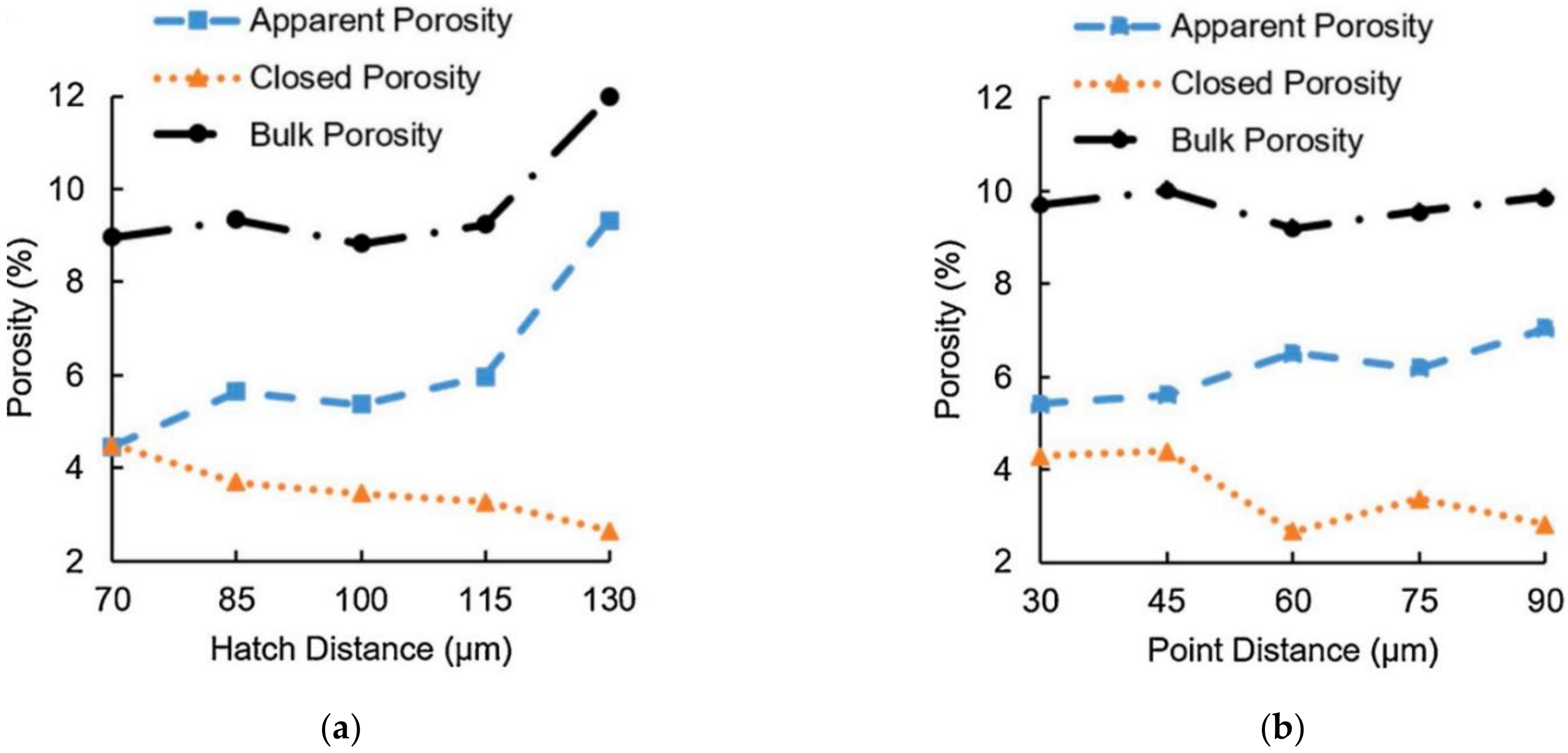
| Relative Density | Process Parameters 1 | Scanning Strategy | Build Chamber Conditions | Post Process Treatment | Ref. |
|---|---|---|---|---|---|
| 98.71% | = 200 W | 67° rotation between layers | 473 K preheating under Argon shield | None | [37] |
| = 200 mm/s | |||||
| = 0.1 mm | |||||
| = 0.03 mm | |||||
| = 1 J/mm | |||||
| = 333 J/mm3 | |||||
| 98.7% | = 360 W | 90° rotation between layers | 353 K preheating under Argon shield | [36] | |
| = 600 mm/s | |||||
| = 0.08 mm | |||||
| = 0.02 mm | |||||
| = 0.6 J/mm | |||||
| = 375 J/mm3 | |||||
| 98.7% | = 150 W | 67° rotation between layers | - Argon shield | None | [44] |
| = 350 mm/s | |||||
| = 0.08 mm | |||||
| = 0.025 mm | |||||
| = 0.43 J/mm | |||||
| = 214 J/mm3 | |||||
| 98.51% | = 300 W | 67° rotation between layers | 473 K preheating under Argon shield | 2 h annealing in vacuum at 1100C | [38] |
| = 300 mm/s | |||||
| = 0.1 mm | |||||
| = 0.03 mm | |||||
| = 1 J/mm | |||||
| = 333 J/mm3 | |||||
| 98.50% | = 200–400 W | 67° rotation between layers | 323 K preheating under Argon shield | None | [39] |
| = 200–300 mm/s | |||||
| = - | |||||
| = 0.02 mm | |||||
| = - | |||||
| = - | |||||
| 98.5% | = 400 W | 90° rotation between layers | 1273 K preheating under Argon shield | None | [40] |
| = 454 mm/s (calculated) | |||||
| = 0.08 mm | |||||
| = 0.04 mm | |||||
| = 0.88 J/mm (calculated) | |||||
| = 275 J/mm3 | |||||
| 98.4% | = 300 W | 67° rotation with double remeltingbetween layers | 453 K preheating under Argon shield | None | [41] |
| = 400 mm/s | |||||
| = - | |||||
| = 0.02 mm | |||||
| = 0.75 J/mm | |||||
| = - | |||||
| 98.4% | = 300 W | 67° rotation between layers | 473 K preheating under Argon shield | None | [43] |
| = 300 mm/s | |||||
| = 0.05 mm | |||||
| = 0.02 mm | |||||
| = 1 J/mm | |||||
| = 1000 J/mm3 | |||||
| 98.31% | = 300 W | 67° rotation between layers | 423 K preheating under Argon shield | None | [42] |
| = 400 mm/s | |||||
| = 0.08 mm | |||||
| = 0.03 mm | |||||
| = 0.75 J/mm | |||||
| = 312 J/mm3 | |||||
| 98.1% | = 300 W | 67° rotation between layers | 453 K preheating under Argon shield | None | [41] |
| = 400 mm/s | |||||
| = - | |||||
| = 0.02 mm | |||||
| = 0.75 J/mm | |||||
| = - | |||||
| 97.5% | = 400 W | 67° rotation with offset between layers | 1273 K preheating under Argon shield | None | [47] |
| = 600 mm/s | |||||
| = 0.1 mm | |||||
| = 0.03 mm | |||||
| = 0.67 J/mm | |||||
| = 222 J/mm3 | |||||
| 97.3% | = 300 W | -- | - Argon shield | None | [35] |
| = 750 mm/s | |||||
| = 0.06 mm | |||||
| = 0.03 mm | |||||
| = 0.4 J/mm | |||||
| = 222 J/mm3 | |||||
| 97% | = 200 W | 67° rotation between layers | - Argon shield | None | [48] |
| = 100 mm/s | |||||
| = 0.115 mm | |||||
| = 0.05 mm | |||||
| = 2 J/mm | |||||
| = 348 J/mm3 | |||||
| 97% | = 400 W | 67° rotation between layers | - Argon shield | Hot Isostatic Pressing | [49] |
| = 300 mm/s | |||||
| = 0.1 mm | |||||
| = 0.03 mm | |||||
| = 1.33 J/mm | |||||
| = 444 J/mm3 |
3. Structure
3.1. Microstructure: Grain Structure and Size Distribution




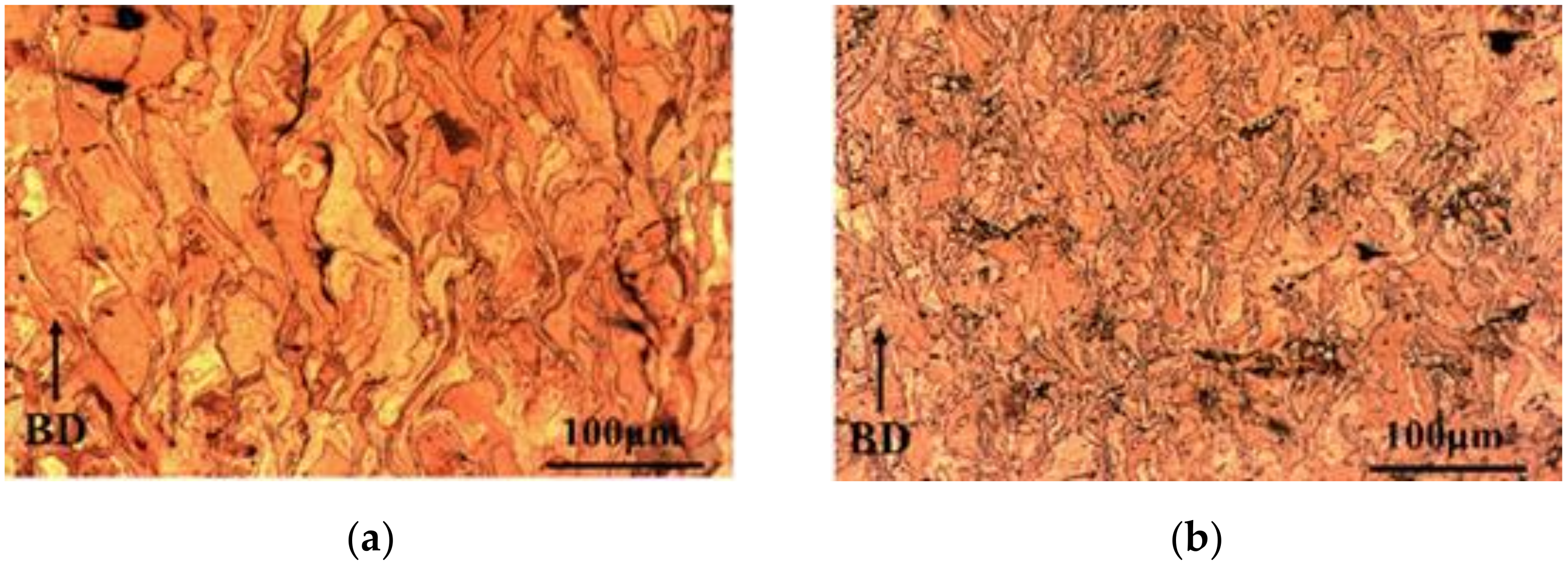
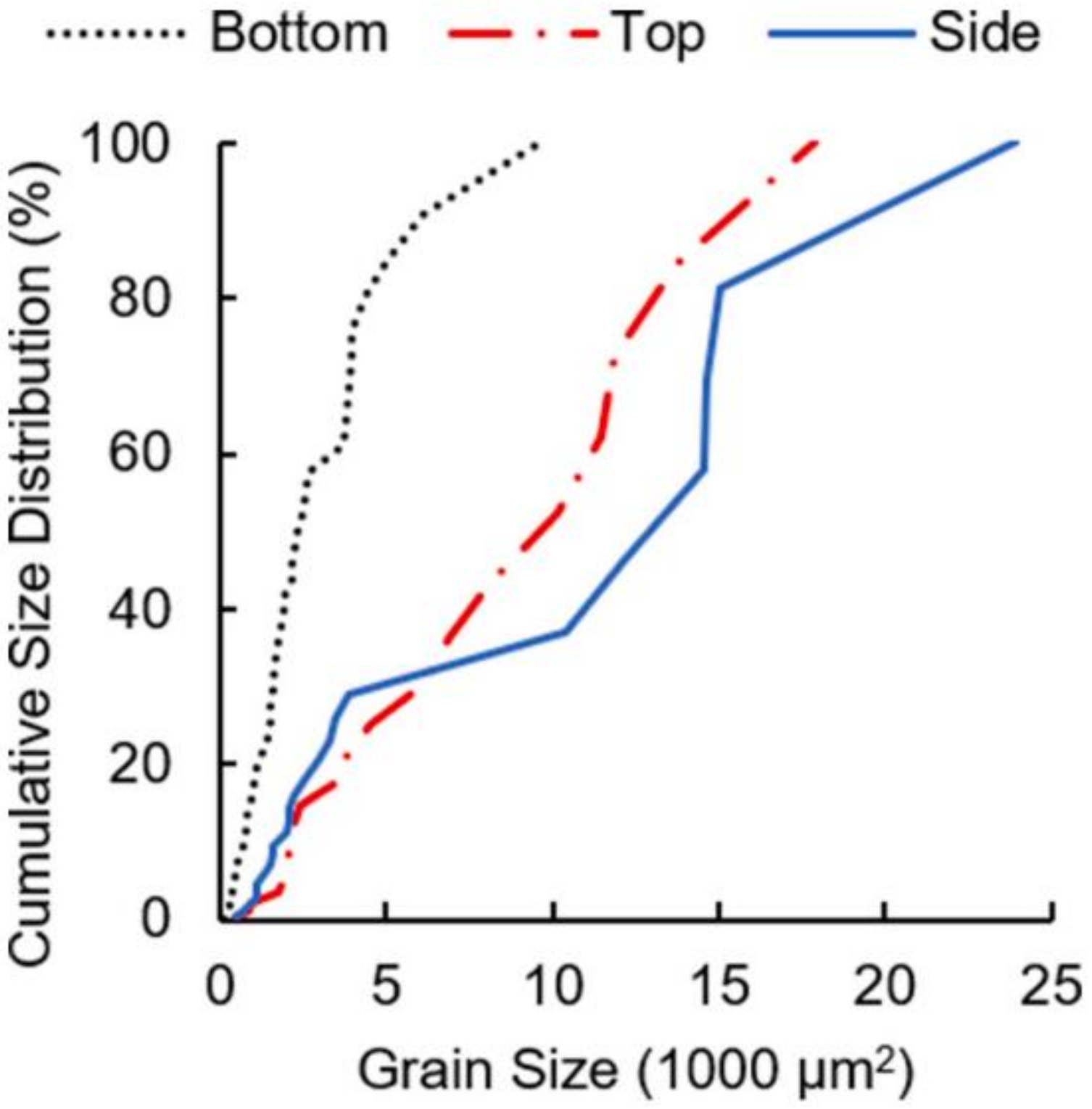
3.2. Microstructural Defects
3.2.1. Balling and Porosity

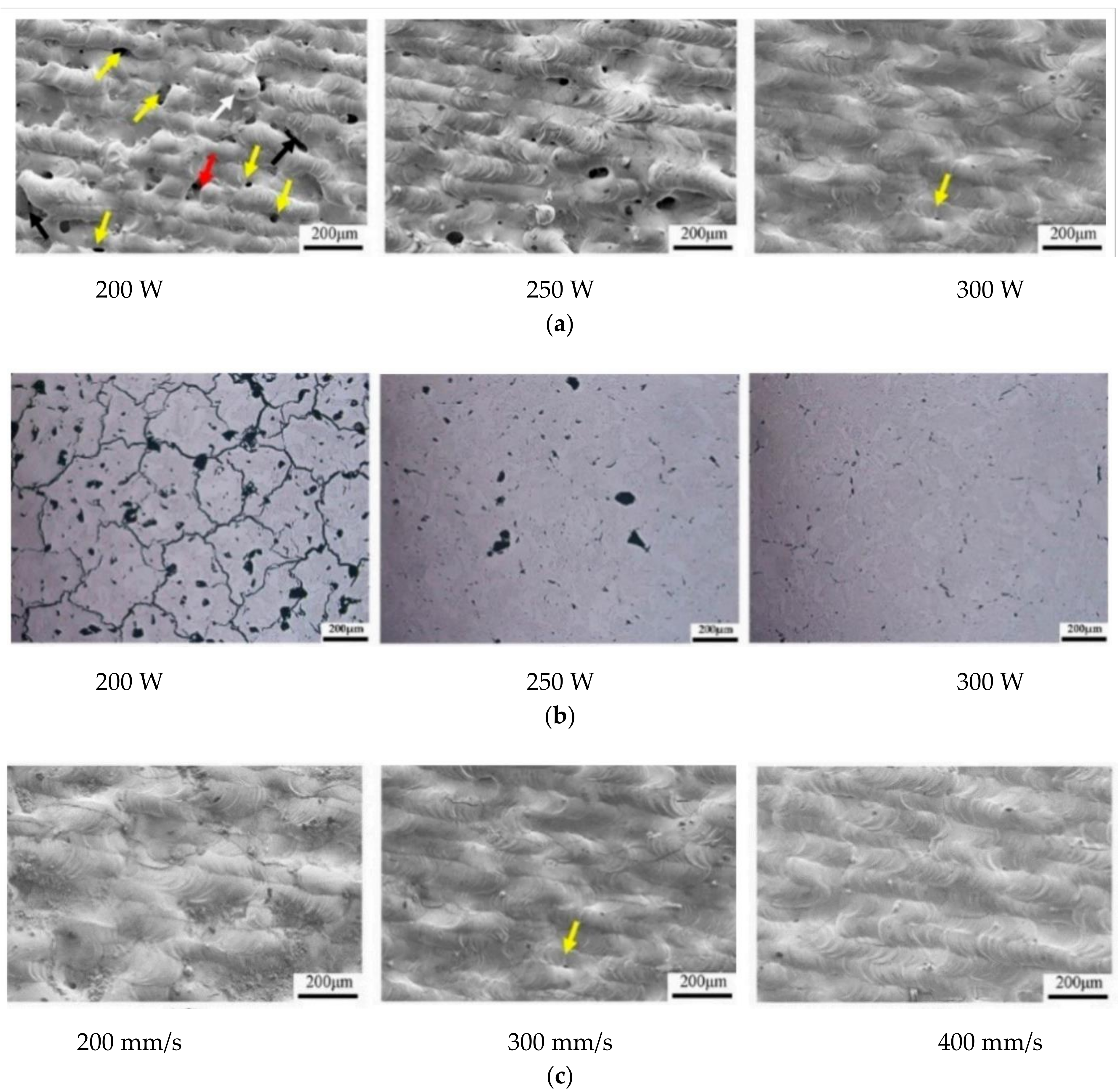

3.2.2. Cracking


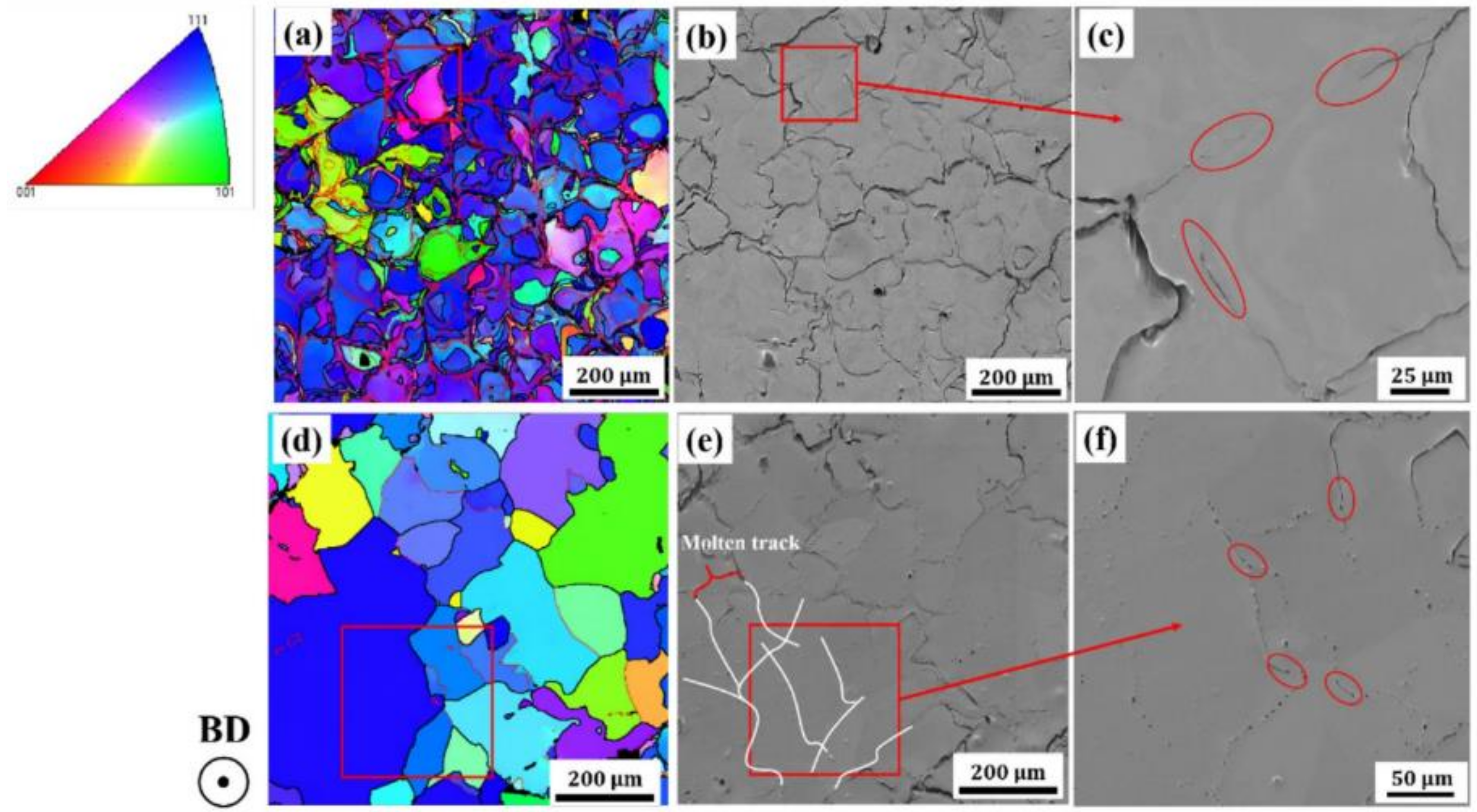
4. Properties

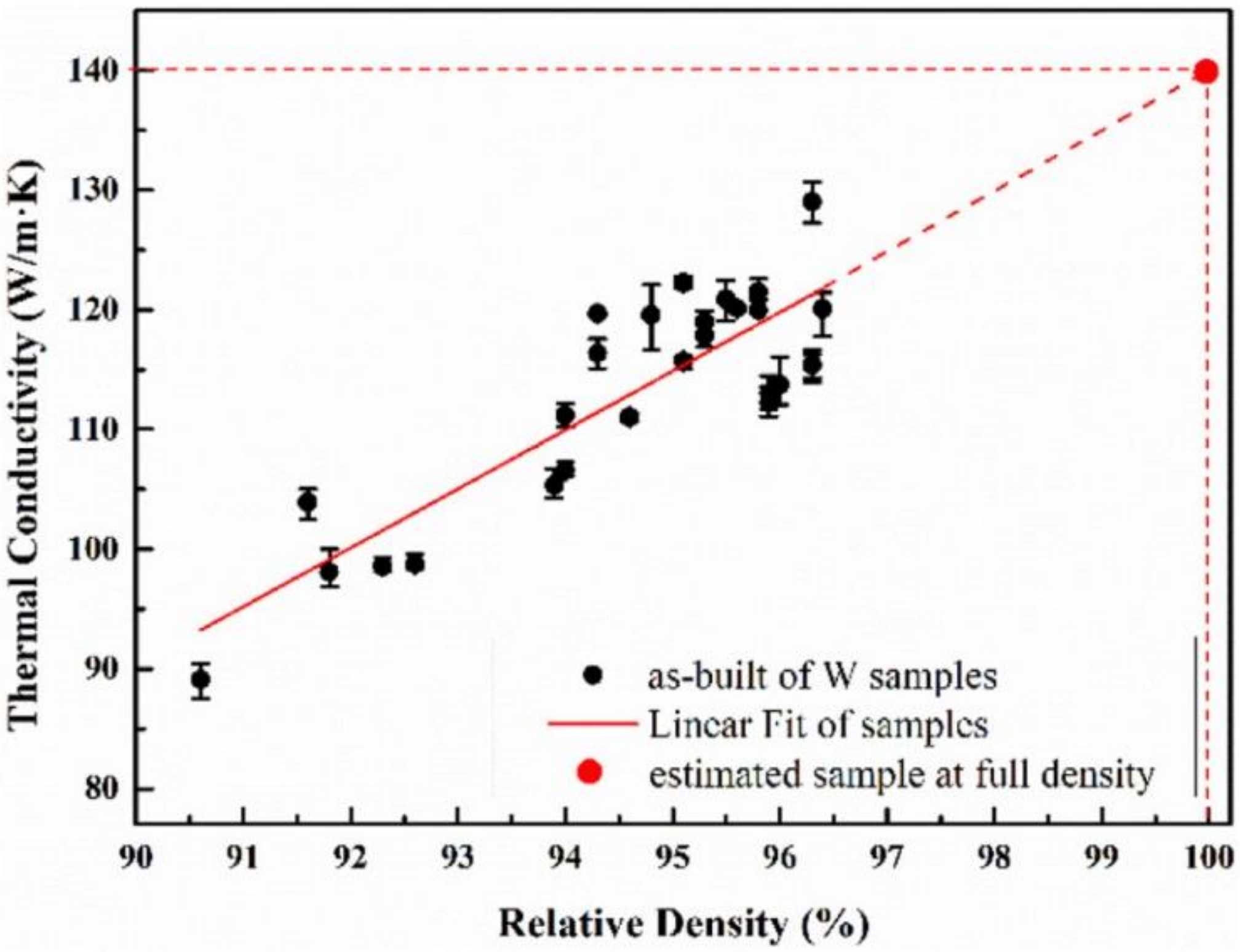
| Ultimate Compressive Strength (MPa) | Yield Compressive Strength (MPa) | Bending Strength (MPa) | Hardness (HV) | Surface Roughness, Ra (µm) | Coefficient of Friction | Wear Resistance mm3/(N m) | Thermal Conductivity W/(m·K) | Ref. |
|---|---|---|---|---|---|---|---|---|
| 1523 | 1067 | -- | 428 | -- | -- | -- | -- | [37] |
| -- | -- | -- | 407 | -- | -- | -- | -- | [36] |
| 1007 | -- | -- | -- | -- | -- | -- | -- | [38] |
| 1015 | 882 | -- | 461 467 1 | 6.74 | -- | -- | -- | [39] |
| 1200 | 1100 1197 1 | 131 | 456 | 14.72 10.62 1 | -- | -- | -- | [41] |
| 902 | -- | -- | 474 | -- | 0.45 | 1.3 × 10–5 | -- | [43] |
| -- | -- | -- | -- | -- | -- | -- | 146 2 | [47] |
| 982 | -- | -- | 370 | -- | -- | -- | -- | [44] |
| -- | -- | -- | -- | -- | -- | -- | 150 | [86] |
| 920 | 480 | [87] |
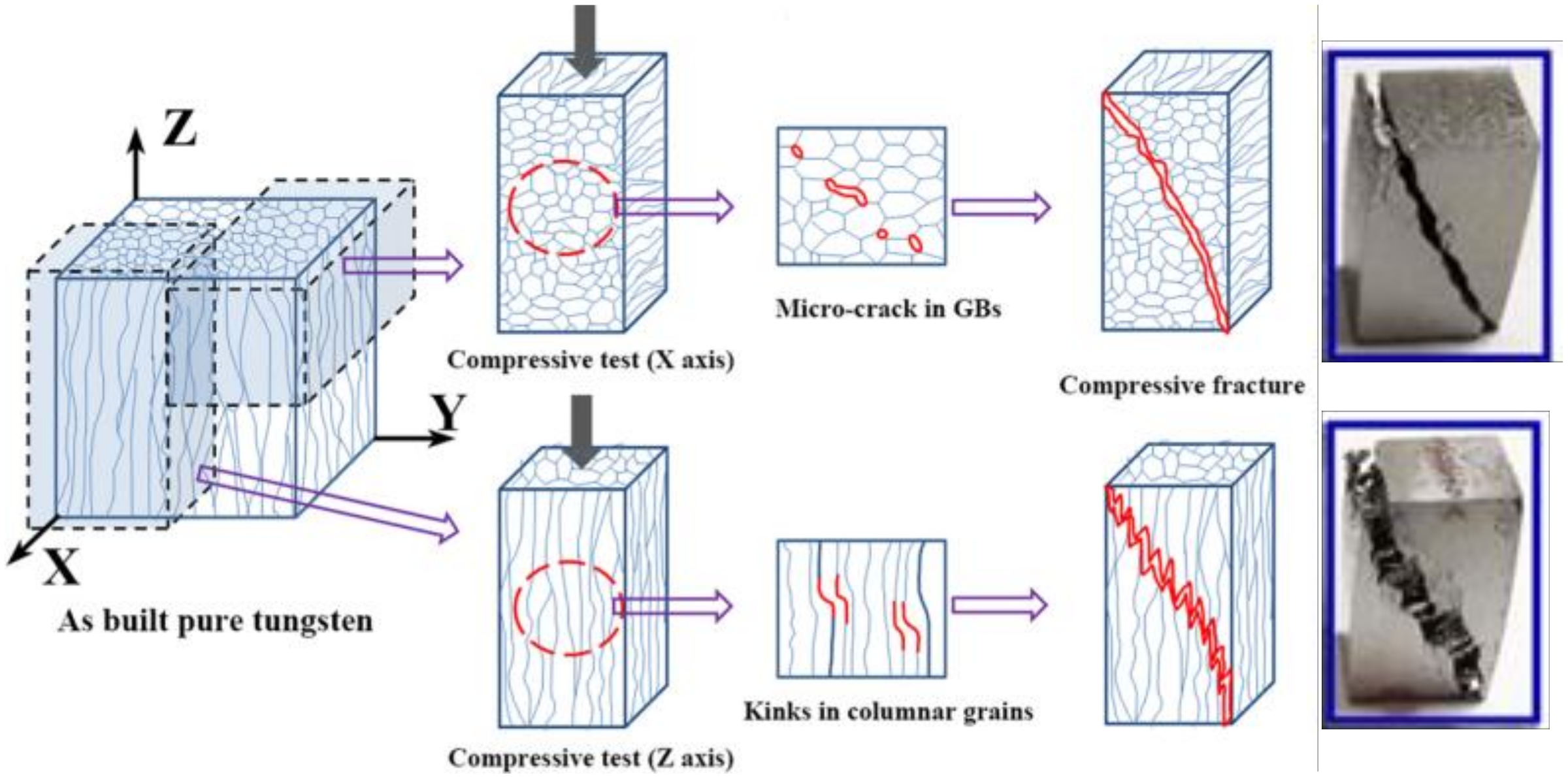
5. Summary and Outlook
- Unalloyed tungsten has been successfully produced by LPBF with up to 98.71% of theoretical density without post-process densification.
- The recommended tungsten feedstock characteristics for high density are spherical powder particles with D10 = 9–10 µm, D50 = 14–17 µm, D90 = 23–25 µm.
- Spherical tungsten powder possesses higher flowability and packing density as compared to faceted irregular powder.
- Numerical studies have shown inverse correlation between powder particle size and the powder absorption of laser energy.
- The LPBF processing window based on literature for high-density unalloyed tungsten is laser power between 200 W and 400 W, scanning speed between 200 mm/s and 400 mm/s, layer thickness between 0.02 mm and 0.03 mm, and hatch distance between 0.08 and 0.1 mm.
- The recommended volumetric energy densities based on the literature range between 300 J/mm3 and 350 J/mm3.
- The expected properties of as-LPBF tungsten (W) include compressive strength of 1523 MPa, yield compressive strength of 1197 MPa, hardness of 474 HV, bending strength of 131 Mpa, and thermal conductivity of 129 Wm−1 K−1.
- Micro-cracks still present a problem in as-LPBF tungsten and could be reduced partially by substrate preheating, hot isostatic pressing, and annealing.
- Laser remelting can significantly improve the surface roughness but can unfavorably promote thermal fatigue crack growth in tungsten.
- HIP after LPBF can cause a minor increase in part densification (0.5%) and a much noticeable increase in thermal conductivity (13%).
- Relative density above 98% could be achieved at lower volumetric energy densities with the aid of substrate preheating (170 J/mm3 and 1273 K preheating).
- Further work is needed to understand the effect of process parameters on part distortion, residual stresses, and spatter formation.
- The evolution of microstructure and bond strength at the substrate/coupon interface when printing tungsten on different substrate material is not discussed in detail in the literature.
- Very limited research has been done on the influence of post processing on mechanical properties.
- To the best of the present authors’ knowledge, properties such as tensile, fatigue, fracture toughness, and impact strength of unalloyed tungsten after LPBF have not been identified in the open literature.
- 3D-printed tungsten anti-scatter grids have been successfully developed and commercialized for medical imaging systems.
- A successful production of tungsten via LPBF will significantly subserve in medical, aerospace, defense, and energy applications.
- The future perspective of the present research topic includes utilization of LPBF technology to produce single-piece tungsten heat exchangers for high heat flux applications as well as single-piece rocket thrusters for space exploration and defense systems.
Author Contributions
Funding
Institutional Review Board Statement
Informed Consent Statement
Data Availability Statement
Conflicts of Interest
References
- Norajitra, P.; Giniyatulin, R.; Hirai, T.; Krauss, W.; Kuznetsov, V.; Mazul, I.; Ovchinnikov, I.; Reiser, J.; Ritz, G.; Ritzhaupt-Kleissl, H.-J.; et al. Current status of He-cooled divertor development for DEMO. Fusion Eng. Des. 2009, 84, 1429–1433. [Google Scholar] [CrossRef]
- Liu, C.-L.; Zhang, J.; Yang, H.; Li, L.; Wang, Z.-L.; Liang, C.; Zhou, Z.-B.; Cao, L.; Yao, D.-M.; Gao, X. The Temperature Control Mechanism of a Breeding Blanket Module for Fusion Reactor. J. Fusion Energy 2014, 33, 422–427. [Google Scholar] [CrossRef]
- Federici, G.; Boccaccini, L.; Cismondi, F.; Gasparotto, M.; Poitevin, Y.; Ricapito, I. An overview of the EU breeding blanket design strategy as an integral part of the DEMO design effort. Fusion Eng. Des. 2019, 141, 30–42. [Google Scholar] [CrossRef]
- Youchison, D.; Lutz, T.; Williams, B.; Nygren, R. High heat flux testing of a helium-cooled tungsten tube with porous foam. Fusion Eng. Des. 2007, 82, 1854–1860. [Google Scholar] [CrossRef]
- Nygren, R.E.; Youchison, D.L. Testing of Tungsten and Tungsten-Armored Heat Sinks for Fusion Applications; No. SAND2008-5803C; Sandia National Lab. (SNL-NM): Albuquerque, NM, USA, 2008. [Google Scholar]
- Sharafat, S.; Aoyama, A.; Narula, M.; El-Awady, J.; Ghoniem, N.; Williams, B.; Youchison, D. Development Status of the Helium-Cooled Porous Tungsten Heat Exchanger Concept. In 2007 IEEE 22nd Symposium on Fusion Engineering; IEEE: New York, NY, USA, 2007; pp. 1–4. [Google Scholar] [CrossRef]
- Caccia, M.; Tabandeh-Khorshid, M.; Itskos, G.; Strayer, A.R.; Caldwell, A.S.; Pidaparti, S.; Singnisai, S.; Rohskopf, A.D.; Schroeder, A.M.; Jarrahbashi, D.; et al. Ceramic–metal composites for heat exchangers in concentrated solar power plants. Nature 2018, 562, 406–409. [Google Scholar] [CrossRef]
- US6779462B2—Kinetic Energy Rod Warhead with OPTIMAL PENETRATORS—Google Patents. Available online: https://patents.google.com/patent/US6779462 (accessed on 31 March 2021).
- Philipps, V. Tungsten as material for plasma-facing components in fusion devices. J. Nucl. Mater. 2011, 415, S2–S9. [Google Scholar] [CrossRef]
- Lassner, E.; Schubert, W.-D. Tungsten; Springer Science and Business Media LLC: Vienna, Austria, 1999; pp. 124–125. [Google Scholar]
- Nie, B.; Yang, L.; Huang, H.; Bai, S.; Wan, P.; Liu, J. Femtosecond laser additive manufacturing of iron and tungsten parts. Appl. Phys. A 2015, 119, 1075–1080. [Google Scholar] [CrossRef]
- Seltzer, S. Tables of X-ray Mass Attenuation Coefficients and Mass Energy-Absorption Coefficients; National Institute of Standards and Technology-PL: Gaithersburg, MD, USA, 1995.
- Sayyed, M.I.; Almatari, M. Radiation Shielding Investigation of Lead Borophosphate Glasses Modified by Tungsten Oxide. J. Test. Eval. 2018, 48, 3734–3741. [Google Scholar] [CrossRef]
- Shen, T.; Dai, Y.; Lee, Y. Microstructure and tensile properties of tungsten at elevated temperatures. J. Nucl. Mater. 2016, 468, 348–354. [Google Scholar] [CrossRef]
- Deprez, K.; Vandenberghe, S.; Van Audenhaege, K.; Van Vaerenbergh, J.; Van Holen, R. Rapid additive manufacturing of MR compatible multipinhole collimators with selective laser melting of tungsten powder. Med. Phys. 2012, 40, 012501. [Google Scholar] [CrossRef]
- Kurishita, H.; Matsuo, S.; Arakawa, H.; Sakamoto, T.; Kobayashi, S.; Nakai, K.; Okano, H.; Watanabe, H.; Yoshida, N.; Torikai, Y.; et al. Current status of nanostructured tungsten-based materials development. Phys. Scr. 2014, T159, 014032. [Google Scholar] [CrossRef]
- Wurster, S.; Baluc, N.; Battabyal, M.; Crosby, T.; Du, J.; García-Rosales, C.; Hasegawa, A.; Hoffmann, A.; Kimura, A.; Kurishita, H.; et al. Recent progress in R&D on tungsten alloys for divertor structural and plasma facing materials. J. Nucl. Mater. 2013, 442, S181–S189. [Google Scholar] [CrossRef] [Green Version]
- Sidambe, A.; Judson, D.; Colosimo, S.; Fox, P. Laser powder bed fusion of a pure tungsten ultra-fine single pinhole collimator for use in gamma ray detector characterisation. Int. J. Refract. Met. Hard Mater. 2019, 84, 104998. [Google Scholar] [CrossRef]
- Mullendore, J. Tungsten: Its Manufacture, Properties, and Application. In Refractory Metals and Their Industrial Applications; ASTM International: West Conshohocken, PA, USA, 1984; p. 82. [Google Scholar]
- Rieck, G.D. Tungsten and Its Compounds; Elsevier: Amsterdam, The Netherlands, 2013; ISBN 978-1-4832-0108-5. [Google Scholar]
- Trasorras, J.R.L.; Wolfe, T.A.; Knabl, W.; Venezia, C.; Lemus, R.; Lassner, E.; Schubert, W.-D.; Lüderitz, E.; Wolf, H.-U. Tungsten, Tungsten Alloys, and Tungsten Compounds. Ullmann’s Encycl. Ind. Chem. 2016, 37, 1–53. [Google Scholar] [CrossRef]
- ASTM. ISO/ASTM 52900: 2015 Additive Manufacturing-General Principles-Terminology; ASTM F2792-10e1; ASTM International: West Conshohocken, PA, USA, 2012. [Google Scholar]
- Li, K.-L.; Chen, J.-H.; Zhao, C.-C.; Shen, Z.-J.; Liu, W. A review of tungsten fabricated via laser powder bed fusion. Tungsten 2021, 3, 218–233. [Google Scholar] [CrossRef]
- Gibson, I.; Rosen, D.; Stucker, B.; Khorasani, M. Additive Manufacturing Technologies; Springer International Publishing: Cham, Switzerland, 2021; Volume 17. [Google Scholar]
- Ghasemi, A.; Fereiduni, E.; Balbaa, M.; Jadhav, S.D.; Elbestawi, M.; Habibi, S. Influence of Alloying Elements on Laser Powder Bed Fusion Processability of Aluminum: A New Insight into the Oxidation Tendency. Addit. Manuf. 2021, 46, 102145. [Google Scholar] [CrossRef]
- Yakout, M.; Cadamuro, A.; Elbestawi, M.A.; Veldhuis, S.C. The selection of process parameters in additive manufacturing for aerospace alloys. Int. J. Adv. Manuf. Technol. 2017, 92, 2081–2098. [Google Scholar] [CrossRef]
- Zhang, D.; Cai, Q.; Liu, J. Formation of Nanocrystalline Tungsten by Selective Laser Melting of Tungsten Powder. Mater. Manuf. Process. 2012, 27, 1267–1270. [Google Scholar] [CrossRef]
- Ebert, R.; Ullmann, F.; Hildebrandt, D.; Schille, J.; Hartwig, L.; Kloetzer, S.; Streek, A.; Exner, H. Laser processing of tungsten powder with femtosecond laser radiation. J. Laser Micro Nanoeng. 2012, 7, 38. [Google Scholar] [CrossRef]
- Zhou, X.; Liu, X.; Zhang, D.; Shen, Z.; Liu, W. Balling phenomena in selective laser melted tungsten. J. Mater. Process. Technol. 2015, 222, 33–42. [Google Scholar] [CrossRef]
- Zhang, J.; Gu, D.; Yang, Y.; Zhang, H.; Chen, H.; Dai, D.; Lin, K. Influence of Particle Size on Laser Absorption and Scanning Track Formation Mechanisms of Pure Tungsten Powder During Selective Laser Melting. Engineering 2019, 5, 736–745. [Google Scholar] [CrossRef]
- Wang, L.-Z.; Wu, J.-J.; Zhang, D.-J. Properties evolution of additive manufacture used tungsten powders prepared by radio frequency induction plasma. Int. J. Refract. Met. Hard Mater. 2017, 67, 90–97. [Google Scholar] [CrossRef]
- Zi, X.; Chen, C.; Wang, X.; Wang, P.; Zhang, X.; Zhou, K. Spheroidisation of tungsten powder by radio frequency plasma for selective laser melting. Mater. Sci. Technol. 2018, 34, 735–742. [Google Scholar] [CrossRef]
- Wang, D.; Wang, Z.; Li, K.; Ma, J.; Liu, W.; Shen, Z. Cracking in laser additively manufactured W: Initiation mechanism and a suppression approach by alloying. Mater. Des. 2019, 162, 384–393. [Google Scholar] [CrossRef]
- Wang, D.; Yu, C.; Zhou, X.; Ma, J.; Liu, W.; Shen, Z. Dense Pure Tungsten Fabricated by Selective Laser Melting. Appl. Sci. 2017, 7, 430. [Google Scholar] [CrossRef]
- Field, A.C.; Carter, L.N.; Adkins, N.J.E.; Attallah, M.M.; Gorley, M.J.; Strangwood, M. The Effect of Powder Characteristics on Build Quality of High-Purity Tungsten Produced via Laser Powder Bed Fusion (LPBF). Met. Mater. Trans. A 2020, 51, 1367–1378. [Google Scholar] [CrossRef] [Green Version]
- Gokcekaya, O.; Ishimoto, T.; Todo, T.; Wang, P.; Nakano, T. Influence of powder characteristics on densification via crystallographic texture formation: Pure tungsten prepared by laser powder bed fusion. Addit. Manuf. Lett. 2021, 1, 100016. [Google Scholar] [CrossRef]
- Wen, S.; Wang, C.; Zhou, Y.; Duan, L.; Wei, Q.; Yang, S.; Shi, Y. High-density tungsten fabricated by selective laser melting: Densification, microstructure, mechanical and thermal performance. Opt. Laser Technol. 2019, 116, 128–138. [Google Scholar] [CrossRef]
- Ren, X.; Liu, H.; Lu, F.; Huang, L.; Yi, X. Effects of processing parameters on the densification, microstructure and mechanical properties of pure tungsten fabricated by optimized selective laser melting: From single and multiple scan tracks to bulk parts. Int. J. Refract. Met. Hard Mater. 2021, 96, 105490. [Google Scholar] [CrossRef]
- Tan, C.; Zhou, K.; Ma, W.; Attard, B.; Zhang, P.; Kuang, T. Selective laser melting of high-performance pure tungsten: Parameter design, densification behavior and mechanical properties. Sci. Technol. Adv. Mater. 2018, 19, 370–380. [Google Scholar] [CrossRef] [PubMed] [Green Version]
- Müller, A.V.; Schlick, G.; Neu, R.; Anstätt, C.; Klimkait, T.; Lee, J.; Pascher, B.; Schmitt, M.; Seidel, C. Additive manufacturing of pure tungsten by means of selective laser beam melting with substrate preheating temperatures up to 1000 °C. Nucl. Mater. Energy 2019, 19, 184–188. [Google Scholar] [CrossRef]
- Xiong, Z.; Zhang, P.; Tan, C.; Dong, D.; Ma, W.; Yu, K. Selective Laser Melting and Remelting of Pure Tungsten. Adv. Eng. Mater. 2020, 22, 1901352. [Google Scholar] [CrossRef]
- Li, J.; Wu, Y.; Zhou, B.; Wei, Z. Laser Powder Bed Fusion of Pure Tungsten: Effects of Process Parameters on Morphology, Densification, Microstructure. Materials 2020, 14, 165. [Google Scholar] [CrossRef]
- Guo, M.; Gu, D.; Xi, L.; Zhang, H.; Zhang, J.; Yang, J.; Wang, R. Selective laser melting additive manufacturing of pure tungsten: Role of volumetric energy density on densification, microstructure and mechanical properties. Int. J. Refract. Met. Hard Mater. 2019, 84, 105025. [Google Scholar] [CrossRef]
- Zhou, K.; Chen, W.; Yang, Y.; Li, R.; Dong, L.; Fu, Y.-Q. Microstructure and mechanical behavior of porous tungsten skeletons synthesized by selected laser melting. Int. J. Refract. Met. Hard Mater. 2021, 103, 105769. [Google Scholar] [CrossRef]
- Todo, T.; Ishimoto, T.; Gokcekaya, O.; Oh, J.; Nakano, T. Single crystalline-like crystallographic texture formation of pure tungsten through laser powder bed fusion. Scr. Mater. 2021, 206, 114252. [Google Scholar] [CrossRef]
- Balbaa, M.; Ghasemi, A.; Fereiduni, E.; Elbestawi, M.; Jadhav, S.; Kruth, J.-P. Role of powder particle size on laser powder bed fusion processability of AlSi10mg alloy. Addit. Manuf. 2021, 37, 101630. [Google Scholar] [CrossRef]
- Braun, J.; Kaserer, L.; Stajkovic, J.; Leitz, K.-H.; Tabernig, B.; Singer, P.; Leibenguth, P.; Gspan, C.; Kestler, H.; Leichtfried, G. Molybdenum and tungsten manufactured by selective laser melting: Analysis of defect structure and solidification mechanisms. Int. J. Refract. Met. Hard Mater. 2019, 84, 104999. [Google Scholar] [CrossRef]
- Sidambe, A.; Tian, Y.; Prangnell, P.; Fox, P. Effect of processing parameters on the densification, microstructure and crystallographic texture during the laser powder bed fusion of pure tungsten. Int. J. Refract. Met. Hard Mater. 2019, 78, 254–263. [Google Scholar] [CrossRef]
- Chen, J.; Li, K.; Wang, Y.; Xing, L.; Yu, C.; Liu, H.; Ma, J.; Liu, W.; Shen, Z. The effect of hot isostatic pressing on thermal conductivity of additively manufactured pure tungsten. Int. J. Refract. Met. Hard Mater. 2020, 87, 105135. [Google Scholar] [CrossRef]
- Seyam, M.S.; Shazly, M.; El-Mokadem, A.; Wifi, A.S. A binding scheme to minimize thinning of formed tailor welded blanks. Int. J. Adv. Manuf. Technol. 2018, 96, 3933–3950. [Google Scholar] [CrossRef]
- Das, S. On some physical aspects of process control in direct selective laser sintering of metals part I. In 2001 International Solid Freeform Fabrication Symposium; The University of Texas at Austin: Austin, TX, USA, 2001. [Google Scholar] [CrossRef]
- Lampman, S. (Ed.) Weld Integrity and Performance: A Source Book Adapted from ASM International Handbooks, Conference Proceedings, and Technical Books; ASM International: Novelty, OH, USA, 1997; ISBN1 1615032045. ISBN2 9781615032044. [Google Scholar]
- Wang, D.; Li, K.; Yu, C.; Ma, J.; Liu, W.; Shen, Z. Cracking behavior in additively manu-factured pure tungsten. Acta Metall. Sin. Engl. Lett. 2019, 32, 127–135. [Google Scholar] [CrossRef] [Green Version]
- Huang, J.; Li, M.; Wang, J.; Pei, Z.; Mclntyre, P.; Ma, C. Selective laser melting of tungsten: Effects of hatch distance and point distance on pore formation. J. Manuf. Process. 2021, 61, 296–302. [Google Scholar] [CrossRef]
- Aversa, A.; Moshiri, M.; Librera, E.; Hadi, M.; Marchese, G.; Manfredi, D.; Lorusso, M.; Calignano, F.; Biamino, S.; Lombardi, M.; et al. Single scan track analyses on aluminium based powders. J. Mater. Process. Technol. 2018, 255, 17–25. [Google Scholar] [CrossRef]
- Yadroitsev, I.; Gusarov, A.; Yadroitsava, I.; Smurov, I. Single track formation in selective laser melting of metal powders. J. Mater. Process. Technol. 2010, 210, 1624–1631. [Google Scholar] [CrossRef]
- Yueling, G.U.O.; Lina, J.I.A.; Bin, K.O.N.G.; Na, W.A.N.G.; Zhang, H. Single track and single layer formation in selective laser melting of niobium solid solution alloy. Chin. J. Aeronaut. 2018, 31, 860–866. [Google Scholar]
- Kruth, J.-P.; Levy, G.; Klocke, F.; Childs, T.H.C. Consolidation phenomena in laser and powder-bed based layered manufacturing. CIRP Ann. 2007, 56, 730–759. [Google Scholar] [CrossRef]
- Xie, Y.-J.; Yang, H.-C.; Wang, X.-B.; Zhao, L.; Kuang, C.-J.; Han, W. Control of wall thickness and surface morphology of tungsten thin wall parts by adjusting selective laser melting parameters. J. Iron Steel Res. Int. 2019, 26, 182–190. [Google Scholar] [CrossRef]
- Vrancken, B.; Ganeriwala, R.K.; Matthews, M.J. Analysis of laser-induced microcracking in tungsten under additive manufacturing conditions: Experiment and simulation. Acta Mater. 2020, 194, 464–472. [Google Scholar] [CrossRef]
- Childs, T.H.C.; Hauser, C.; Badrossamay, M. Selective laser sintering (melting) of stainless and tool steel powders: Experiments and modelling. Proc. Inst. Mech. Eng. Part B J. Eng. Manuf. 2005, 219, 339–357. [Google Scholar] [CrossRef]
- Kruth, J.; Froyen, L.; Rombouts, M.; Van Vaerenbergh, J.; Mercells, P. New Ferro Powder for Selective Laser Sintering of Dense Parts. CIRP Ann. 2003, 52, 139–142. [Google Scholar] [CrossRef]
- Rombouts, M.; Froyen, L.; Kruth, J.-P.; Van Vaerenbergh, J.; Mercelis, P. Production and properties of dense iron based parts produced by laser melting with plasma formation. In Proceedings of the Powder Metallurgy World Congress, Vienna, Austria, 1 October 2004; Volume 5, pp. 115–121, ISBN 1-899072-15-2. [Google Scholar]
- Stephens, J.R. Review of Deformation Behavior of Tungsten at Temperature Less Than 0.2 Absolute Melting Temperature; No. NASA-TM-X-2482; NTRS-NASA: Washington, DC, USA, 1 January 1972.
- Iveković, A.; Omidvari, N.; Vrancken, B.; Lietaert, K.; Thijs, L.; Vanmeensel, K.; Vleugels, J.; Kruth, J.-P. Selective laser melting of tungsten and tungsten alloys. Int. J. Refract. Met. Hard Mater. 2018, 72, 27–32. [Google Scholar] [CrossRef]
- Ren, C.; Fang, Z.; Koopman, M.; Butler, B.; Paramore, J.; Middlemas, S. Methods for improving ductility of tungsten—A review. Int. J. Refract. Met. Hard Mater. 2018, 75, 170–183. [Google Scholar] [CrossRef]
- Xu, A.; Beck, C.; Armstrong, D.E.; Rajan, K.; Smith, G.D.; Bagot, P.A.; Roberts, S.G. Ion-irradiation-induced clustering in W–Re and W–Re–Os alloys: A comparative study using atom probe tomography and nanoindentation measurements. Acta Mater. 2015, 87, 121–127. [Google Scholar] [CrossRef] [Green Version]
- Rieth, M.; Boutard, J.; Dudarev, S.; Ahlgren, T.; Antusch, S.; Baluc, N.; Barthe, M.-F.; Becquart, C.; Ciupinski, L.; Correia, J.; et al. Review on the EFDA programme on tungsten materials technology and science. J. Nucl. Mater. 2011, 417, 463–467. [Google Scholar] [CrossRef]
- Xie, Z.; Zhang, T.; Liu, R.; Fang, Q.; Miao, S.; Wang, X.; Liu, C. Grain growth behavior and mechanical properties of zirconium micro-alloyed and nano-size zirconium carbide dispersion strengthened tungsten alloys. Int. J. Refract. Met. Hard Mater. 2015, 51, 180–187. [Google Scholar] [CrossRef]
- Bhattarai, J.; Akiyama, E.; Habazaki, H.; Kawashima, A.; Asami, K.; Hashimoto, K. The influence of concentration of hydrochloric acid solutions on the passivation behavior of sputter-deposited tungsten rich W–Nb alloys. Corros. Sci. 1998, 40, 1897–1914. [Google Scholar] [CrossRef]
- Arshad, K.; Zhao, M.-Y.; Yuan, Y.; Zhang, Y.; Zhao, Z.-H.; Wang, B.; Zhou, Z.-J.; Lu, G.-H. Effects of vanadium concentration on the densification, microstructures and mechanical properties of tungsten vanadium alloys. J. Nucl. Mater. 2014, 455, 96–100. [Google Scholar] [CrossRef]
- Tanabe, T.; Eamchotchawalit, C.; Busabok, C.; Taweethavorn, S.; Fujitsuka, M.; Shikama, T. Temperature dependence of thermal conductivity in W and W–Re alloys from 300 to 1000 K. Mater. Lett. 2003, 57, 2950–2953. [Google Scholar] [CrossRef]
- Xie, Z.; Liu, R.; Miao, S.; Yang, X.D.; Zhang, T.; Wang, X.P.; Fang, Q.F.; Liu, C.S.; Luo, G.N.; Lian, Y.Y.; et al. Extraordinary high ductility/strength of the interface designed bulk W-ZrC alloy plate at relatively low temperature. Sci. Rep. 2015, 5, 16014. [Google Scholar] [CrossRef]
- Tejado, E.; Carvalho, P.; Munoz, A.; Dias, M.; Correia, J.B.; Mardolcar, U.; Pastor, J.Y. The effects of tantalum addition on the microtexture and mechanical behaviour of tungsten for ITER applications. J. Nucl. Mater. 2015, 467, 949–955. [Google Scholar] [CrossRef] [Green Version]
- Pintsuk, G.; Kurishita, H.; Linke, J.; Arakawa, H.; Matsuo, S.; Sakamoto, T.; Kobayashi, S.; Nakai, K. Thermal shock response of fine- and ultra-fine-grained tungsten-based materials. Phys. Scr. 2011, T145, 014060. [Google Scholar] [CrossRef]
- Wurster, S.; Gludovatz, B.; Hoffmann, A.; Pippan, R. Fracture behaviour of tungsten-vanadium and tungsten-tantalum alloys and composites. J. Nucl. Mater. 2011, 413, 166–176. [Google Scholar] [CrossRef]
- Garfinkle, M.; Witzke, R.W.; Klopp, W.D. Superplasticity in Tungsten-Rhenium Alloys; National Aeronautics and Space Administration: Washington, DC, USA, 1 August 1968; Volume 4728.
- Arshad, K.; Yuan, Y.; Cheng, L.; Wang, J.; Zhou, Z.-J.; De Temmerman, G.; Lu, G.-H. Deuterium blistering in tungsten and tungsten vanadium alloys. Fusion Eng. Des. 2016, 107, 25–31. [Google Scholar] [CrossRef]
- Gu, D.; Dai, D.; Chen, W.; Chen, H. Selective Laser Melting Additive Manufacturing of Hard-to-Process Tungsten-Based Alloy Parts with Novel Crystalline Growth Morphology and Enhanced Performance. J. Manuf. Sci. Eng. 2016, 138, 081003. [Google Scholar] [CrossRef]
- Li, K.; Ma, G.; Xing, L.; Wang, Y.; Yu, C.; Chen, J.; Ma, J.; Wu, G.; Liu, W.; Shen, Z.; et al. Crack suppression via in-situ oxidation in additively manufactured W-Ta alloy. Mater. Lett. 2020, 263, 127212. [Google Scholar] [CrossRef]
- Li, K.; Li, Y.; Chen, W.; Zhao, C.; Yuan, Y.; Cheng, L.; Morgan, T.; Liu, W.; Shen, Z. Effect of Ta addition on the fuzz formation of additively manufactured W-based materials. Nucl. Fusion 2020, 60, 064004. [Google Scholar] [CrossRef]
- Li, K.; Wang, D.; Xing, L.; Wang, Y.; Yu, C.; Chen, J.; Zhang, T.; Ma, J.; Liu, W.; Shen, Z. Crack suppression in additively manufactured tungsten by introducing secondary-phase nanoparticles into the matrix. Int. J. Refract. Met. Hard Mater. 2019, 79, 158–163. [Google Scholar] [CrossRef]
- Hu, Z.; Zhao, Y.; Guan, K.; Wang, Z.; Ma, Z. Pure tungsten and oxide dispersion strengthened tungsten manufactured by selective laser melting: Microstructure and cracking mechanism. Addit. Manuf. 2020, 36, 101579. [Google Scholar] [CrossRef]
- Liu, K.; Gu, D.; Guo, M.; Sun, J. Effects of processing parameters on densification behavior, microstructure evolution and mechanical properties of W–Ti alloy fabricated by laser powder bed fusion. Mater. Sci. Eng. A 2021, 829, 142177. [Google Scholar] [CrossRef]
- Bai, S.; Liu, J.; Yang, P.; Huang, H.; Yang, L.-M. Femtosecond fiber laser additive manufacturing of tungsten. In Optical Pattern Recognition IX; SPIE: Washington, DC, USA, 6 April 2016; Volume 9738, p. 97380U-. [Google Scholar]
- Abbas, M.A.; Anru, Y.; Wang, Z.Y. Micro-Structural characteristics of Additively Manufactured Pure Tungsten; IOP Publishing England: Bristol, UK, 2021; Volume 635, p. 012014. [Google Scholar]
- Abbas, M.; Anru, Y.; Wang, Z. On the Use of EBSD and Microhardness to Study the Microstructure Properties of Tungsten Samples Prepared by Selective Laser Melting. Materials 2021, 14, 1215. [Google Scholar] [CrossRef]
- Anti X-ray Scatter Grids|DUNLEE|Radiographic Grids. (n.d.). Retrieved 22 January 2022. Available online: https://www.dunlee.com/a-w/3d-metal-printing/our-offer/anti-scatter-grids-for-ct.html (accessed on 22 January 2022).
- Kinefuchi, K.; Nakata, D.; Coral, G.; Suyalatu; Sakai, H.; Tsukizaki, R.; Nishiyama, K. Additive-manufactured single-piece thin multi-layer tungsten heater for an electrothermal thruster. Rev. Sci. Instrum. 2021, 92, 114501. [Google Scholar] [CrossRef]
- de Prado, J.; Sánchez, M.; Wirtz, M.; Pintsuk, G.; Du, J.; Linke, J.; Ureña, A. High heat flux performance of W-Eurofer brazed joints. J. Nucl. Mater. 2018, 499, 225–232. [Google Scholar] [CrossRef]
- de Prado, J.; Sal, E.; Sánchez, M.; García-Rosales, C.; Ureña, A. Microstructural and mechanical characterization of self-passivating W-Eurofer joints processed by brazing technique. Fusion Eng. Des. 2021, 169, 112496. [Google Scholar] [CrossRef]
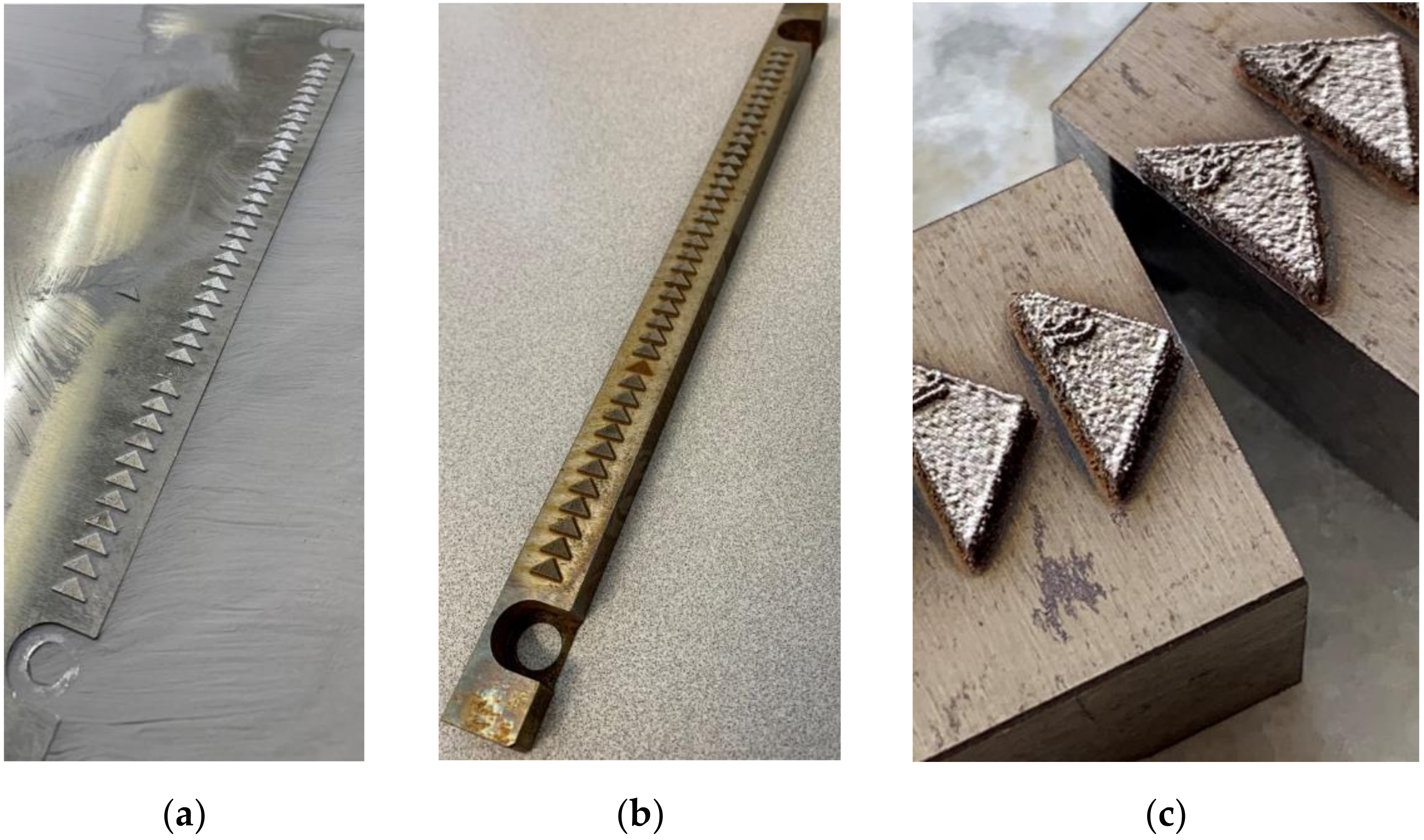
| Balling/Porosity | Cracking |
|---|---|
Cause:
| Cause:
|
Effect:
| Effect:
|
Solution:
| Solution:
|
Publisher’s Note: MDPI stays neutral with regard to jurisdictional claims in published maps and institutional affiliations. |
© 2022 by the authors. Licensee MDPI, Basel, Switzerland. This article is an open access article distributed under the terms and conditions of the Creative Commons Attribution (CC BY) license (https://creativecommons.org/licenses/by/4.0/).
Share and Cite
Seyam, M.S.; Koshy, P.; Elbestawi, M.A. Laser Powder Bed Fusion of Unalloyed Tungsten: A Review of Process, Structure, and Properties Relationships. Metals 2022, 12, 274. https://doi.org/10.3390/met12020274
Seyam MS, Koshy P, Elbestawi MA. Laser Powder Bed Fusion of Unalloyed Tungsten: A Review of Process, Structure, and Properties Relationships. Metals. 2022; 12(2):274. https://doi.org/10.3390/met12020274
Chicago/Turabian StyleSeyam, Mahmoud S., Philip Koshy, and Mohamed A. Elbestawi. 2022. "Laser Powder Bed Fusion of Unalloyed Tungsten: A Review of Process, Structure, and Properties Relationships" Metals 12, no. 2: 274. https://doi.org/10.3390/met12020274
APA StyleSeyam, M. S., Koshy, P., & Elbestawi, M. A. (2022). Laser Powder Bed Fusion of Unalloyed Tungsten: A Review of Process, Structure, and Properties Relationships. Metals, 12(2), 274. https://doi.org/10.3390/met12020274






